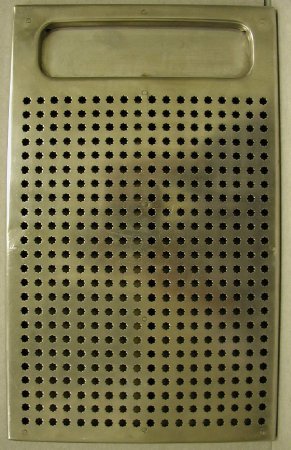Object ID:
1992.74
Title:
Taylor Slate
Creator:
Taylor, William
Description:
This device consists of a rectangular stainless steel type frame, 432 octagonal cells are stamped in the top in an 18 x 24 grid, with a recessed oval compartment at one end for holding the extra type when the frame is in use; top folded on sides to wrap around the bottom plate and riveted with eight rivets; a black treated canvas or paper is between the top and the base to serve as a sound buffer; (38) pieces of yellow plastic type.
Dimensions:
H-12 W-7.375 D-0.5 inches
Date:
ca. 1940
Made by:
American Printing House for the Blind
Place of Origin:
Louisville, KY
Collection:
APH Collection
Provenance:
The main purpose of this device was to aid in the teaching and working of problems of long division, multiplication of large numbers, subtraction, and addition.
Set of type originally consisted of 225 separate, identical pieces of type, molded from hard yellow vinyl plastic, or lead type. At one end of type are two dots placed along one side, at the other a solid raised bar along one side. By placing the type into the octagonal holes in the frame, the digits 0-9 and the mathematical signs of operation can be represented.
The Reverend William Taylor became supt. of the Yorkshire School for the Blind in 1836. While at the school he developed his "Ciphering Tablet." His calculating board is mentioned in the 1882 annual report of the British & Foreign Blind Association in essentially the same form as the model produced at APH. Although difficult to master, it possessed several advantages over its main rivals which used raised numbers. Since each piece of type could be used to represent all ten numbers and the operatives, there was significantly less time wasted searching for a particular number. APH introduced its own Taylor Slate in 1938/1939, made from stainless steel. The tools and dies used to produce this slate were donated by the Connecticut School for the Blind in 1937. By 1953, the type was available in both lead and plastic. In 1956, APH began making the frame from anodized green aluminum, which changed to golden aluminum in 1969. The product was discontinued by 1972. Taylor slates were made by several manufacturers, including RNIB, AFB, and APH.
Set of type originally consisted of 225 separate, identical pieces of type, molded from hard yellow vinyl plastic, or lead type. At one end of type are two dots placed along one side, at the other a solid raised bar along one side. By placing the type into the octagonal holes in the frame, the digits 0-9 and the mathematical signs of operation can be represented.
The Reverend William Taylor became supt. of the Yorkshire School for the Blind in 1836. While at the school he developed his "Ciphering Tablet." His calculating board is mentioned in the 1882 annual report of the British & Foreign Blind Association in essentially the same form as the model produced at APH. Although difficult to master, it possessed several advantages over its main rivals which used raised numbers. Since each piece of type could be used to represent all ten numbers and the operatives, there was significantly less time wasted searching for a particular number. APH introduced its own Taylor Slate in 1938/1939, made from stainless steel. The tools and dies used to produce this slate were donated by the Connecticut School for the Blind in 1937. By 1953, the type was available in both lead and plastic. In 1956, APH began making the frame from anodized green aluminum, which changed to golden aluminum in 1969. The product was discontinued by 1972. Taylor slates were made by several manufacturers, including RNIB, AFB, and APH.
Credit Line:
APH Collection, 1992.74
